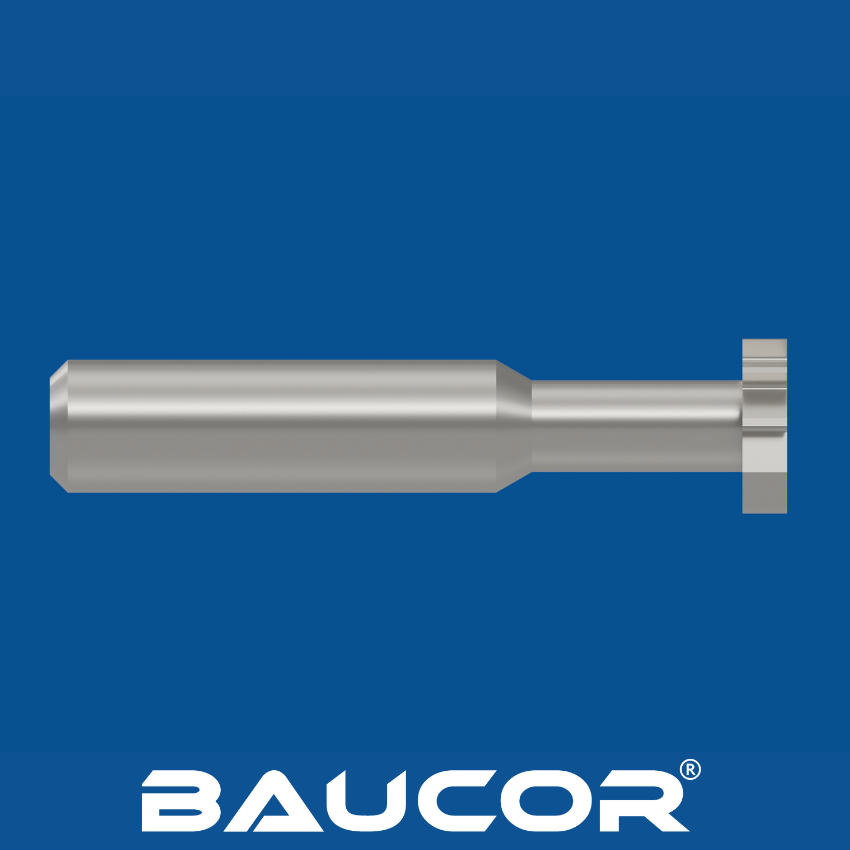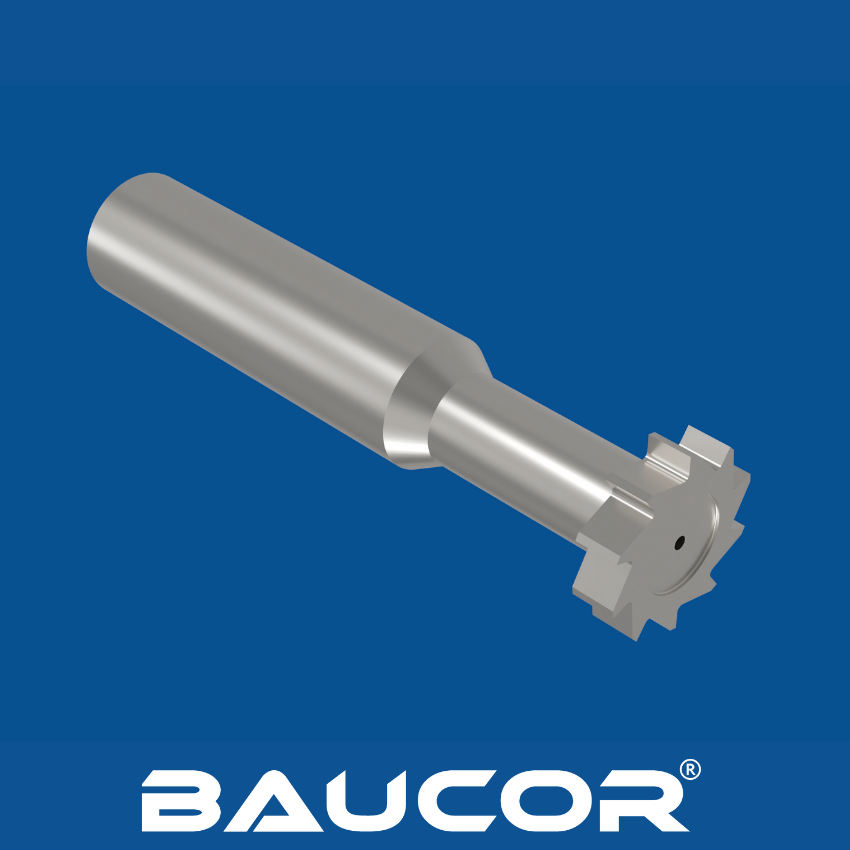DISCOVER THE BAUCOR ADVANTAGE:
MILLS THAT COMBINE POWER, PRECISION, AND DURABILITY FOR A SEAMLESS MILLING EXPERIENCE.
DISCOVER THE BAUCOR ADVANTAGE:
MILLS THAT COMBINE POWER, PRECISION, AND DURABILITY FOR A SEAMLESS MILLING EXPERIENCE.
A Woodruff keyseat cutter, also known as a Woodruff cutter or keyseat cutter, is a specialized milling cutter designed to create semi-circular keyways or slots in a workpiece. These keyways are used to accommodate Woodruff keys, which are small, semi-circular metal wedges that transmit torque between a shaft and a hub (e.g., in gears, pulleys, or couplings).
Sometimes the term "woodruff key end mill" is used interchangeably with the term "keyseat cutter".
How Woodruff Keyseat Cutters Work:
Woodruff keyseat cutters have a unique profile designed to match the shape of the Woodruff key. The cutter features a single cutting edge that forms the semi-circular shape of the keyway as it rotates. The cutting edge is typically made of high-speed steel (HSS) or carbide for durability and efficient cutting.
The working process involves the following steps:
Applications of Woodruff Keyseat Cutters:
Woodruff keyseat cutters are widely used in various industries, including:
Advantages of Woodruff Keyseat Cutters:
By understanding the function and applications of Woodruff keyseat cutters, engineers and machinists can effectively utilize these tools to create precise and reliable keyways for various mechanical assemblies.

Woodruff keyseat cutters, also known as Woodruff cutters, are manufactured through a precise process that involves several key steps:
Material Selection: The first step is choosing the appropriate material for the cutter. Common choices include:

Blank Preparation: The selected material is cut into cylindrical blanks of the desired diameter. These blanks are then heat-treated to improve their hardness and durability.
Grinding: The blanks are mounted on specialized grinding machines where precision grinding wheels shape the cutting edge and create the specific semi-circular profile required for Woodruff keyway cutting. This process is critical for ensuring accurate and consistent keyway dimensions.
Quality Control: Thorough inspection and testing are conducted to ensure that the Woodruff keyseat cutters meet the required specifications for dimensions, profile accuracy, and cutting performance. This may involve dimensional inspection using precision measuring tools and cutting tests on sample workpieces.
Packaging and Distribution: The finished Woodruff keyseat cutters are carefully packaged and shipped to distributors or end-users.
Manufacturing Techniques:
Several manufacturing techniques are used to produce Woodruff keyseat cutters:
Challenges in Manufacturing:
Manufacturing Woodruff keyseat cutters presents some challenges:
Advancements in Manufacturing:
The manufacturing of Woodruff keyseat cutters continues to evolve, with ongoing research and development focusing on:
New Materials: Exploring novel materials with improved properties like hardness, toughness, and heat resistance.
Advanced Coatings: Developing new coating technologies to enhance tool life, performance, and versatility.
Automation: Implementing automation and robotics to streamline the manufacturing process and improve efficiency.

A chipbreaker end mill is a cutting tool featuring specially designed notches or geometries along its cutting edges.

Double angle shank cutters are specialized cutting tools used for various machining operations, particularly those requiring intricate V-groove profiles.

Full radius keyseat cutters are specialized milling tools designed to create semi-circular keyseats within shafts or bores.

As a leading manufacturer of cutting tools, Baucor likely offers a wide range of Woodruff keyseat cutter sizes to cater to diverse industrial needs. While specific size availability may vary based on their product line and current inventory, you can generally expect Baucor to manufacture Woodruff keyseat cutters in various sizes to accommodate different Woodruff key dimensions.
Keyseat cutters are typically specified by the following parameters:
Baucor offers a comprehensive selection of cutter diameters, keyway widths, and depths to match various Woodruff key sizes and application requirements.
For the most accurate and up-to-date information on the specific sizes available for Baucor Woodruff keyseat cutters, it's recommended to refer to their official product catalog or website. You can also contact their sales representatives or authorized distributors who can provide detailed information on the available sizes, materials, and other specifications.
As a top manufacturer, Baucor is committed to offering a wide range of Woodruff keyseat cutter sizes and configurations to meet the specific needs of its customers across different industries and applications.

Back corner rounding end mill is a specialized cutting tool designed to create precise radii (rounded corners) on the backside of a workpiece (the side facing away from the machine spindle).



An Engraving Cutter with a Radius is a precision cutting tool designed for engraving and detailing, featuring a tip with a rounded radius to create smooth, curved cuts and intricate designs on various materials.
Woodruff keyseat cutters (also known as Woodruff cutters) are typically made from a select range of materials, each offering specific advantages for different applications.
Common Materials:
Less Common Materials:
The choice of material for a Woodruff keyseat cutter depends on several factors:
It's important to note that Woodruff keyseat cutters are not typically coated like other cutting tools, as the coating could interfere with the precise fit of the Woodruff key in the keyway.

Lollipop cutters, also known as undercut end mills or ball nose end mills with necks, are specialized cutting tools used for a variety of machining tasks.

A clearance cutter, more commonly known as a square end mill, is a versatile rotary cutting tool used in CNC milling machines.

A Double-End Corner Rounding End Mill is a cutting tool with rounded cutting edges on both ends, used to create rounded corners or radii on the edges of a workpiece, enhancing efficiency by allowing use of both ends.

A Clearance Cutter - Ball End Mill is a type of end mill with a rounded tip (ball end) and a reduced diameter or relieved shank, designed to provide clearance for machining intricate surfaces, deep cavities, and complex shapes while minimizing tool interference.
Woodruff keyseat cutters (also known as Woodruff cutters) are generally not coated. The reason for this is that coatings, while improving wear resistance and performance in other cutting tools, can interfere with the precise fit of the Woodruff key in the keyway. The slight increase in dimensions caused by a coating could prevent the key from seating properly.
However, there are some exceptions:
It's important to note that if a coated Woodruff keyseat cutter is used, the keyway might need to be machined slightly larger to accommodate the coating thickness. This is usually only done in specific applications where the improved performance of a coated cutter outweighs the potential fitment issues.
In most cases, uncoated Woodruff keyseat cutters made from high-quality materials like high-speed steel (HSS) or carbide are sufficient for creating accurate and functional keyways.
If you are considering a coated Woodruff keyseat cutter, it's crucial to consult with the manufacturer or a tooling expert to ensure that the coating will not negatively impact the functionality of the keyway and assembly.
Woodruff keyseat cutters (also known as Woodruff cutters) are used in a wide range of industries and applications where precise keyways are needed to secure components onto shafts. These keyways accommodate Woodruff keys, semi-circular metal wedges that transmit torque and prevent slippage between the shaft and the component.
Here are some of the key industries and applications where Woodruff keyseat cutters are commonly used:
Industries:
Specific Applications:
Overall, Woodruff keyseat cutters play a crucial role in various industries by enabling the creation of precise and reliable keyways for a wide range of mechanical assemblies. Their versatility, efficiency, and cost-effectiveness make them essential tools for engineers and machinists across various sectors.
Woodruff keyseat cutters, often referred to as Woodruff key end mills, are essential tools in various industries for creating keyways to secure components onto shafts. These keyways accommodate Woodruff keys, which are semi-circular metal wedges that transmit torque and prevent slippage between the shaft and the component.
Industries that utilize Woodruff keyseat cutters include:
Additional Industries:
Overall, Woodruff keyseat cutters are versatile tools that find applications in a wide range of industries. Their ability to create precise keyways for secure and reliable component mounting makes them essential for various engineering and manufacturing processes.
Woodruff keyseat cutters are primarily used in machines designed for milling operations to create precise semi-circular keyways in workpieces. These machines provide the necessary rotational speed, control, and rigidity to effectively utilize Woodruff keyseat cutters.
Here are some of the common machines that use Woodruff keyseat cutters:
Milling Machines:
CNC Machines (Computer Numerical Control):
Keyseating Machines:
In addition to these machines, Woodruff keyseat cutters can also be used with handheld rotary tools for small-scale or DIY projects. However, the precision and control may not be as high as with dedicated milling machines or CNC machines.
The choice of machine depends on several factors, including the size and complexity of the workpiece, the desired precision, the material being machined, and the overall production volume. While milling machines and CNC machines are the most common choices for professional applications, keyseating machines offer a specialized solution for high-volume keyway production.

End Mill Neck Relief is the reduced diameter section behind the cutting edge of an end mill, designed to provide clearance and reduce tool deflection during deep cutting operations.

T-Slot End Mills are specifically designed to cut T-shaped slots, commonly used for securing components in machinery.

Tapered Ball Nose End Mill is a specialized cutting tool with a tapered body and rounded tip, ideal for 3D contouring and smooth surface finishing in CNC milling and engraving applications.

Pointed chamfer cutters are a type of end mill used specifically for creating chamfers – angled cuts that transition between two surfaces.
Baucor, as a leading manufacturer of cutting tools, likely offers a range of design and engineering support services for their Woodruff keyseat cutters, although the specifics may vary. Here's what you might expect:
To get the most accurate and up-to-date information on the specific design and engineering support services offered by Baucor for our Woodruff keyseat cutters, it's best to contact us directly through our website or customer service channels.

BAUCOR offers custom manufacturing and engineering solutions tailored to your specific needs, across various industries.

BAUCOR's engineers can review your design and provide feedback to improve manufacturability, cost effectiveness, and efficiency.


Designing Woodruff keyseat cutters involves careful consideration of several factors to ensure optimal performance, tool life, and the creation of accurate keyways. Here are the key design guides:
Cutter Profile:
Material Selection:
Cutter Diameter:
Additional Considerations:
By carefully considering these design guides and working with experienced tool manufacturers or engineers, you can select or design Woodruff keyseat cutters that are optimized for your specific machining needs. This will ensure accurate keyway creation, extended tool life, and reliable performance in your applications.